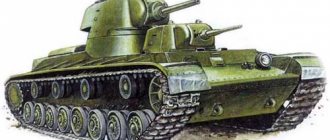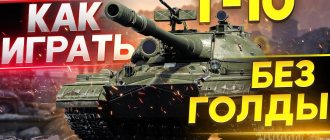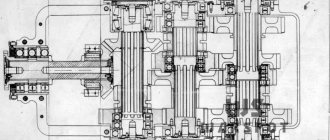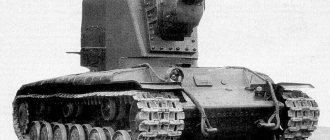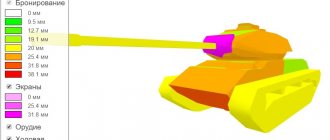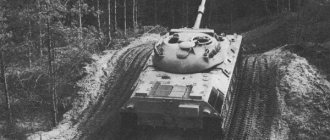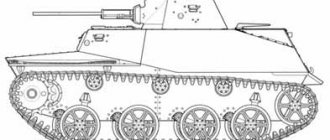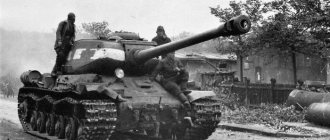By December 1955, the list of necessary improvements had grown to 144 items. The most significant problems identified concerned elements of the turret rotation, gun guidance and fire control systems; there were also questions regarding the power plant and the level of operational characteristics of the tank as a whole.
The turret controls did not provide the ability to accurately aim the gun and save specified settings. Since the tank had to fire at long distances, a ballistic computer was required.
M103 from the 2nd Heavy Tank Battalion of the 7th American Army in Germany. At the rear of the tank there is a platform for additional fuel tanks.
To ensure the convenience of the crew members servicing the gun and machine guns, it was considered necessary to have a rotating floor for the fighting compartment. It was considered inappropriate to combine the duties of a gunner with operating a rangefinder and firing from a gun.
The situation was complicated by the fact that by the end of 1955 there was no longer any urgent need for a heavy tank. The Korean War was over, and the fate of the 80 T43E1 tanks ordered by the army was in doubt. As a result, a major rework of the T43E1 was abandoned, limiting itself to eliminating “only” 98 identified deficiencies and giving up on the mentioned defects of the turret and fire control system.
In February 1956, Chrysler agreed to a plan to carry out such a limited modernization, and on April 26, the Ordnance Department certified the T43E1 tank as the “120mm Gun Tank M103”, and the T123E1 120mm gun installed on it received the designation M58. By the beginning of 1957, 74 tanks had been modernized and sent for military testing at Fort Hood, Texas. The six other tanks built remained at the disposal of the Armament Directorate as test vehicles.
Description M103
The M103 heavy tank was armed with a long-barreled 120-mm M58 cannon with a muzzle brake and an ejection device, as well as two 7.62-mm machine guns coaxial with the cannon, and one 12.7-mm anti-aircraft machine gun, which was mounted openly on the commander's turret and had a remote control control. The tank did not have a weapon stabilizer. The M103 ammunition consisted of 38 separate-loading rounds of 120 mm caliber, 1,000 rounds of 12.7 mm caliber and 5,250 rounds of 7.62 mm caliber.
The tank's hull and hemispherical turret were made in one piece. The rear part of the tower was significantly raised above the roof of the hull.
The vehicle was equipped with duplicate fire control drives installed at the commander and gunner locations. The main sighting device for direct fire was a stereoscopic horizontal-base rangefinder-sight located at the gunner, and the auxiliary one was a periscope sight with six-fold magnification.
Four periscopic observation devices were mounted in the commander's cupola, providing all-round visibility. One periscope observation device was installed in the loader's area.
The driver was located in the control compartment, which was located in the front of the hull, and the rest of the crew were in the turret. The driver had at his disposal three daytime periscopic observation devices mounted in the roof of the control compartment and providing him with a forward view of the area up to 180°. When driving at night, the driver used the M19 infrared periscope, which was installed instead of the central daytime periscope viewing device. The tank was controlled using a steering wheel; gears were changed using a lever that had five fixed positions.
At the rear of the tank, in the power compartment, a 12-cylinder, four-stroke, air-cooled Continental AV-1790-5B gasoline engine was installed, equipped with direct fuel injection equipment, which developed a power of 810 hp at 2,800 rpm. With. A hydromechanical power transmission of the “Cross Drive” type, similar to that equipped with the M47 and M48 medium tanks, was also located here.
The design of the chassis of the M103 tank included seven road wheels and six support rollers per side. Three front and two rear road wheels on each side were equipped with shock absorbers. The caterpillar tracks had rubber-metal joints.
The tank was equipped with one of the standard tank radios AN/GRC-3 (4) or AN/VRC-7, an intercom and a radio station for communication with aviation. To communicate between the infantry and the crew, there was a telephone at the rear of the vehicle.
However, the Marine Corps command did not agree to a “truncated” modernization, insisting on its own requirements for the 220 tanks it ordered, and refused to accept them in the M103 version certified by the ground forces. As a result, the 8th Marine Heavy Tank Battalion continued to serve without heavy tanks, and the equipment intended for it languished in a warehouse in Newark awaiting completion of testing of the T43E2 prototypes.
The shot for the 120 mm cannon had impressive dimensions
As already mentioned, the most significant modifications to the T43E1/M103 required the fire control system, which operated unsatisfactorily. And since the tank was originally intended to perform the same task as the English heavy tank Conqueror - fighting from long range with Soviet heavy tanks IS-3 and T-10, this was unacceptable. Therefore, in the modification T43E2 they tried to provide “reliable and stable aiming, which would not be disrupted by shock loads caused by movement over rough terrain or shells hitting the turret.” In addition, at the May 1953 conference, it was decided to move the gunner’s position forward to the gun so that he could use the telescopic sight mounted to the right of the gun (instead of the second coaxial machine gun). It was assumed that the reconfigured tank turret would house new gun guidance drives and a new fire control system, including not only an optical sight, but also a ballistic computer coupled with the gunner’s periscope sight and the tank commander’s rangefinder. In addition, a rotating crew compartment floor, a simplified commander's cupola with a 12.7 mm machine gun on an open turret (fire could only be fired by leaning out of the hatch) and a turret-mounted basket for property were installed.
Marine Corps M103A1 on training in California
For the new gun guidance control system, engineers used modern technology used in the navy for ship guns, replacing the electro-hydraulic system previously installed in the tank. The new all-electric "amplidyne" system used powerful servos on electric motors to ensure rapid rotation of the heavy turret. The rangefinder, which was now controlled not by the gunner, but by the tank commander, measured distances up to 4,000 meters. The actions of the tank commander were limited to detecting the target and measuring the range to it. The gunner manually entered data on the type of projectile and external conditions into the ballistic computer, after which the gun was automatically installed at the required elevation angle. The gunner's periscope sight made it possible to easily determine distances using the existing sighting reticle.
All this made it possible for the gunner to freely select targets and monitor the shooting results, making the necessary adjustments. If necessary, the tank commander could also control the gun's fire based on data from his rangefinder. In the event that the fire control system was disabled, the gunner's new telescopic sight allowed him to estimate the range to the target using a reticle calibrated for two different types of ammunition.
M103 during an exercise
By early 1957, testing of the T43E2 prototype had been successfully completed, and the Army standardized it as the M103A1 on May 17. The new version of the tank already fully satisfied the requirements of the army, but it did not plan to order new heavy tanks.
The Marines also liked the new modification - the Commandant of the Marine Corps notified the Chief of Staff of the Ground Forces that he was satisfied with the results of the T43E2 tests and considered the modified tank suitable for combat use. As a result, by July 1959, all 220 Marine Corps tanks were upgraded to the M103A1 standard. Interestingly, the army also did not stand aside and later “borrowed” 72 M103A1 units from the Marines.
After military tests at Fort Hood, the M103 tanks ordered by the ground forces were sent overseas to join the 7th Army stationed in Germany. By the end of 1957, they re-equipped the 899th heavy tank battalion (from May 12, 1958, renamed the 2nd heavy tank battalion), based in Hanau. The battalion was part of the 4th Armored Group of the 5th Corps and previously operated on M48 medium tanks in anticipation of receiving new heavy vehicles. The battalion had a unique organization - four companies of 18 tanks, each with six platoons of three tanks.
M103A2 Marine Corps
The Army soon showed interest in replacing its M103s with the more advanced Marine variant, the M103A1. The army's request was granted, and in May-June 1959, 72 M103A1 tanks were transported to Europe. The terms of this "loan" included the Army's obligation to return the tanks back to the Marine Corps in their original condition. And indeed, at the beginning of 1963, at the end of the lease period, all M103A1 tanks were returned. The 2nd Heavy Tank Battalion, which remained horseless, was reorganized and transferred to the 3rd Armored Division.
From the beginning of 1959, M103A1s began to arrive in Marine Corps units. Taking into account the fact that the Armament Directorate retained one vehicle for testing, the number of vehicles delivered to the US Marine Corps was 219 (received registration numbers 232954–233172). According to the standards adopted by the Marine Corps, in peacetime three divisional tank battalions, each with three tank companies, were to be armed with heavy tanks. In wartime, reinforced tank battalions were supposed to have a three-company strength, and a divisional battalion had to have a four-company strength. The first to move to the M109A1 in January 1959 was the 2nd tank battalion on the Atlantic coast, and in February-March the 1st and 3rd tank battalions on the Pacific coast. Several more vehicles were received by training units. The remaining 155 M103A1 tanks were supposed to be stored in depots on the western (88 units) and on the east coast (67 units).
Gunner's position in the M103A2 tank
Taking into account the future participation of heavy tanks in amphibious operations, by the beginning of the 50s, the US Navy developed designs for ships and landing craft that could transport medium and heavy tanks, as well as heavy amphibians of the LVTP-5 series. The 62.5-ton M103A1 could be transported in the holds of military cargo ships, on LST-class tank landing ships and delivered ashore by LCM-8 landing craft. The Navy modified them to allow tanks to fire sideways and forward as they approached the landing site, making individual tank craft unnecessary.
During the Cuban Missile Crisis of October 1962, significant U.S. military forces were deployed near the island at sea and at nearby land bases. Thus, the 2nd Marine Division provided security for the naval base at Guantanamo Bay in Cuba itself. After the end of the acute phase of the crisis, heavy tanks from Company C of the 2nd Tank Battalion were sent here. Every six months (on a rotational basis) five heavy tanks and two flamethrower tanks were sent to the base. Two of them were constantly stationed at a forward fortified post, from which observation of minefields and obstacles was provided to prevent a surprise attack. The sending of heavy tanks to Cuba was justified by the presence of Soviet heavy tanks IS-2, medium T-55 and self-propelled guns Su-100. The M103 tanks that visited Guantanamo turned out to be the only US Marine Corps tanks of this series that were used “overseas” in a situation close to combat. Even when units of the US Marine divisions deployed in the Pacific region (1st, 3rd and part of the 5th) were sent to Vietnam, their heavy tanks remained “at home” due to the lack of suitable targets.
M103A2 at the Georgia storage base, late 70s
In the early 60s, the leadership of the Marine Corps began to look for a replacement for their M103A1. Initially, it was planned to purchase a promising main battle tank being developed for the ground forces. However, after curtailing this program in favor of the development of the new American-German MBT70 tank, the Marines realized that they could not expect a new main tank in the near future, and made efforts to extend the service life of their heavy M103 tanks and medium M48 tanks.
By that time, a modernization program for the fleet of medium tanks M48 had already been developed, including the installation of a diesel engine, a new rangefinder, an OPVT system from the M60 and a redesign of the engine compartment. The same improvements were proposed for the M103A1. The Commandant of the Marine Corps approved research into the effectiveness of such an upgrade “with the installation of as many M60 components as possible.” On June 5, 1961, reworking of two prototypes began, designated M103A1E1. After their tests, in August 1962, an order was issued for the conversion of 153 M103A1 tanks. The re-equipment was supposed to be carried out starting in August 1963, at a rate of 25 vehicles per month. Upgraded tanks, certified as M103A2, began returning to Marine units in May 1964.
Tank M103 on display at the museum
On the M103A2, the gasoline engine was replaced by the Continental AVDS-1790-2AD diesel engine, which was used on the M60 tank. At the same time, the capacity of the fuel tanks was increased, as a result the tank’s cruising range increased from 129 to 480 km! The maximum speed reached 37 km/h, and due to the higher torque of the diesel engine, it was easier to overcome various obstacles. The stereoscopic rangefinder was replaced by the monocular M24 with scale graduations in meters. On most vehicles, an infrared spotlight was installed above the gun, which could also operate in the visible spectrum. Thanks to the new roof of the engine compartment, it was possible to develop a kit for overcoming deep fords that was much more practical than that adopted on earlier modifications.
In 1968, 53 more tanks were modified to the M103A2 standard, bringing the total number of M103A2s (including prototypes) to 208. The M103A2s remained in service until 1973, when they were replaced by the latest models of the M60 main battle tank.
Early M103
The adoption of the M103 heavy tank led to the need to create a new repair and recovery vehicle, since the existing ones were not powerful enough to tow a heavy tank. Chrysler quickly solved this problem by producing 200 ARVs, which were given the designation M51. The new repair and recovery vehicle weighed 54 tons, had a crew of 4 people and was equipped with coulters in the front and rear, a crane with a lifting capacity of 30 tons and a winch with a lifting capacity of over 60 tons. The M51 was in service until 1973–1974.
Breaking through a tank.
You can penetrate the upper part of the NLD, but you should be careful and not shoot at the very junction of the upper and lower armor plates.
As for the turret, there is a hatch that is very large, but the damage only occurs in half the shots.
And there is also the old problem of T30 and T34, when they easily penetrated the forehead of the tower around the mantlet. The M103 inherited the same problem. The tank's turret breaks through the edges of the forehead.
When the tank is at an angle towards us, we should shoot at the edge of the NLD closest to us, because it itself is not very convex and the angles of the armor become more straight, we will not penetrate into the far one. Damage to the tank does not pass through the sides.
The side of the tower becomes for us at an even better angle, where we can consistently penetrate, and this is the most advantageous point, because the ammunition storage is located there. The commander's huge turret is still being penetrated by us.
The case breaks through easily, without any unnecessary problems. But the tower is taken only in the rear part, because there is very weak armor there and also in the side triplexes.
Well, as you understand, when shooting at the rear, the tank penetrates very easily.
* * *
To summarize, we can say that the hasty launch into mass production of the still “raw” M103 as part of the emergency “Tank Crash Program” adopted in response to the outbreak of the Korean War led to serious problems in the process of putting the tank into service, and even to the disappointment of the army in this car. It was only the Marine Corps' commitment to the heavy tank program that brought the M103 to effective operational status.
M103A1, 1962
However, despite all the problems, before the advent of the era of anti-tank missiles, the United States did not have any other weapon system other than the M103, which could be guaranteed to destroy Soviet heavy tanks that were in service until the early 70s.
As for the soldiers who served on the M103, the tank was popular and respected among them for its powerful weapons. Even the existing difficulties in the work of crew members, for example, the second loader, who loaded heavy shells and charges into the gun chamber in a narrow turret while moving, were perceived with a sense of pride.
For the driver, operating the tank was comparable in simplicity to the much lighter M48 series medium tanks. True, they had to monitor the very long gun barrel and warn the gunner about the need to raise or unscrew the barrel before passing various obstacles.
Although the total weight of the vehicle came close to 64 tons with the new engine and increased fuel capacity, the tank easily overcame the same obstacles as before. The weak point remained the shock absorber of the front suspension roller balancer, which, as a rule, overheated when driving, especially in the hot California desert, where retraining for modernized vehicles took place.
Due to the large size of the breech of the 120-mm cannon and the narrow frontal projection of the turret, the gunner and his instruments were in more cramped conditions than in medium tanks.
M103A2, 1972
While firing from the M103, an unpleasant problem was discovered - the recoil of the powerful 120-mm gun, even despite the significant weight of the tank, caused it to sway on its suspension. As a result, the gunner lost sight of the target, since the picture in the sight went up. This effect necessitated repeated search and acquisition of the target and made it pointless to use tracer ammunition or watch for gaps to determine necessary adjustments. The electrically powered servos ("amplidyne") guidance system required an initial "warm-up" and very careful balancing of the servos using the vertical and horizontal potentiometer knobs to prevent drift during further operation.
In 1972, after serving for 14 years and 20 years after production, the M103 heavy tanks were retired. They fulfilled their intended role, demonstrating a robust design that achieved the maximum achievable levels of armor protection, firepower and mobility allowed by the technology of the time. They were replaced by modern main tanks comparable in mass, but significantly superior in fire power, protection and mobility.
Tips for the game.
Perhaps, today’s main advice would be to keep a distance from the enemy and behave like a st, it’s not for nothing that most players, including myself, consider this tank “Fat Patton”. Due to the good accuracy and rate of fire of the gun, you should not be the first to get into trouble and take damage, but be behind the backs of others and calmly inflict damage on the enemy. Also, you should not be afraid of st and you can go 1 on 1 with the enemy, they won’t be able to spin you, and their penetration is worse than yours.
Modifications
- T43E1
is the name of tanks produced in 1951-1954. - M103
is the name of the tanks after they were put into service, modernized and standardized in 1956 (the gun carried 35 rounds of ammunition). - M103A1 (T43E2)
- 219 tanks that underwent modernization in 1958-1959. It features an increased (up to 38 rounds) ammunition capacity and an improved fire control system. - M103A1E1 (M103A2)
- 159 tanks that underwent modernization in 1964. It is distinguished by the installation of an AVDS-1790 “Continental” diesel engine, a correspondingly modernized power transmission, high-capacity aluminum fuel tanks and some suspension elements of the M60 tank. As a result, the tank's cruising range was increased to 480 km, and the maximum speed was increased to 37 km/h. As practice has shown, the maximum speed was almost impossible to achieve, however, over rough terrain the tank quickly picked up a speed of 27 km/h, and without reducing the speed it turned the chassis.
Service
In Europe, the US Army fielded only one battalion of heavy tanks, from January 1958, originally assigned to the 899th Armor, later redesignated the 2/33rd Armor. The US Army heavy armor battalion, in contrast to other armor units, was organized into four tank companies, composed of six platoons each, of which each platoon contained three M103's, for a total of 18 tanks per company. Standard US Army armor battalions at the time had three companies per battalion, each with three five-tank platoons, with 17 tanks per company (two tanks were in headquarters platoon). The US Marine Corps assigned one M103 company to each of its 3 Marine tank battalions, including its Marine reserve units. While the US Army deactivated its heavy armor units with the reception of the new M60 series main battle tanks in 1963, the remaining M103s remained within the US Marine Corps inventory until they began receiving the M60 series MBT. With the disappearance of the heavy tank from US forces came the full acceptance of the main battle tank in 1960 for the US Army, and 1973 for the US Marine Corps. Although the 21st century's M1 Abrams MBT utilizes the same caliber of main gun, the 120 mm, the M103's cannon was a rifled gun firing a fixed round, ejecting a lengthy brass shell casing (34.69 inches in length for the armor-piercing rounds). The M1 tank's 120 mm main gun is a smooth bore (no rifling) firing a semi-caseless round, ejecting only a back cap of the original loaded round; the bulk of the 120 mm shell's casing is consumed during firing. Ammunition fired by the M103's M58 cannon included:
- APBC-T M358 Shot
- HEAT-T M469 Shell
- HE-T M356 Shell
- TP-T M359E2 Shot
Equipment
The choice of equipment for the T-103 provides for increased firepower, since the main role of the tank destroyer is to cause damage. Therefore, the optimal choice would be:
- a large-caliber gun rammer is required to be installed, because this AT has a long reload time, and by increasing the rate of fire you can significantly increase the average damage per minute;
- stereo tube - will add 95 meters to the basic view of the car, thereby bringing this figure to the maximum value;
- reinforced aiming drives - given the presence of the turret, sometimes we will have to move out from behind cover and the faster the guns are brought down, the better for us, of course;
If you already have a pumped-up crew with the “Combat Brotherhood” skill, then instead of aiming drives you can install:
- improved ventilation Class 3 - will add 5% to the crew’s skills, slightly increasing all characteristics of the vehicle.
Vehicles based[edit]
M51edit
Main article: M51
BREM M51.
US heavy armored recovery vehicle from the 1950s. Created between 1951 and 1954 using components from the M103 heavy tank. During serial production in 1954–1955, a total of 187 M51 ARVs were produced, which remained in service until the 1970s.
M48 Patton III edit
Main article: M48 Patton III
The US medium tank, developed in 1950-1951, as a new generation tank, was intended to replace the obsolete M46 and M47 in the US armed forces. The design of the tank was based on the M103 heavy tank. In addition, the tank used a number of design innovations, such as a fully cast hull and ellipsoidal turret. Serial production of the tank began in 1952 and continued until 1959, when it was replaced on the assembly line by its successor, the M60 main battle tank. A total of 11,703 M48 tanks were produced during this period in several variants. Since the mid-1960s, most M48s have been upgraded to levels close to the base M60.
Design and Development
Like the contemporary British Conqueror tank, the M103 was designed to counter Soviet heavies such as the Josef Stalin tank or the T-10 if a conventional World War III broke out. Its long-ranged 120 mm cannon was designed to hit enemy tanks at extreme distances, but it was never used in combat. In 1953-1954 a series of 300 tanks, initially designated T43E1, were built by Chrysler at the Newark plant. Testing was unsatisfactory, and the tanks were all stored in August 1955. Only after recommending improvements, on 26 April 1956 the tank was standardized as the M103 Heavy Tank. Of the 300 T43E1s built, 80 went to the US Army (74 of which were rebuilt to M103 standard), and 220 were accepted by the US Marine Corps, to be used as infantry support, rebuilt to improved M103A1, then M103A2 standards. The successful versions of the M103 shared many components with the M47 and M48 Patton tanks and the M60, which, with the exception of the M60 (a main battle tank) were all considered 90 mm gun (medium) tanks. Tracks, rollers and suspension elements were the same, with some modification to take into account the greater weight. The engine and transmission were never modified enough to give the extra power needed for the greater weight of the M103, and as a result, the tank was relatively underpowered and the drive systems were fragile. The turret of the M103 was larger than that of the M48 or the M60 to make room for the huge 120 mm gun and the two loaders assigned to it, in addition to the gunner and the commander. The driver sat in the hull. The gun was capable of elevation from +15 to -8 degrees. The armor is made from welded rolled and cast homogeneous steel of varying thickness.
- Hull front: 100–130 mm (4.0–5.3 in)
- Hull side: 76 mm (3.1 in)
- Hull top: 25 mm (1 in)
- Turret mantlet: 250 mm (10.2 in)
- Turret front: 180 mm (7.3 in)
- Turret side: 76 mm (3.1 in)
- Turret top: 38 mm (1.5 in)
Notes
- ↑ R.P. Hunnicutt.
Firepower: A History of the American Heavy Tank. - Presidio Press, 1988. P. 219. - , With. 24.
- S. Ustyantsev, D. Kolmakov.
T-54/55. - Nizhny Tagil: Uralvagonzavod / Media-Print, 2006. - P. 216-218. — (Combat vehicles of Uralvagonzavod No. 3). — 4500 copies. — ISBN 5-98485-026-5. - M. V. Pavlov, I. V. Pavlov.
Domestic armored vehicles 1945-1965 // Equipment and weapons: yesterday, today, tomorrow. - Moscow: Tekhinform, 2009. - No. 2. - P. 39-40. - R. P. Hunnicutt.
Patton: A History of American Medium Tank Volume I. - 1st ed. - Novato, CA: Presidio Press, 1984. - P. 440. - ISBN 0-89141-230-1. - , p. 10.
- M. Baryatinsky, M. Kolomiets, A. Koshchavtsev.
Soviet heavy post-war tanks. - M.: Bronekollektsiya, issue No. 3, 1996. p.32
Footnotes
- By commander's periscope
- All tanks that have them have active infrared
- Armor is indicated in brackets
- ↑ Cast armor part of complex shape; equivalent thickness indicated
- 10mm steel anti-cumulative screen
- 6mm steel anti-cumulative screen
- Author: Vladimir
Rate this article:
- 5
- 4
- 3
- 2
- 1
(0 votes, average: 0 out of 5)
Share with your friends!
similar posts from this section
Unusual Soviet tank “Object 279” In Poland, police stopped the tank The Russian military will finally receive the T-90M tank this year
German giants
Let's move on to the next vehicle - the E 100. This is a super-heavy attack aircraft, for which both security and firepower are important. However, in the current situation, the tank lives not due to its armor, but due to its high safety margin and high one-time damage. To correct this situation, we will improve the frontal armor of the E 100 turret: from now on it will be more difficult to hit the turret’s armor plate. Especially if you position the turret correctly relative to the enemy shot. Improving the aiming time for the 15 cm gun will also allow the E 100 to spend less time exposing vulnerable areas of the turret to enemy shots and improve survivability.
Improvements to the 12.8 cm Kw.K gun. 44 L/55 are inherited from lower level vehicles. These changes are intended to provide a more effective alternative to the 15 cm Kw.K gun. L/38
It is important to note that now a gun similar to the 12.8 cm is installed on many other German tanks, however, the change in one-time damage will be implemented only for tanks from the E 100 branch by replacing the projectile. By analogy with this, the change in one-time damage will be made for tanks of lower levels of this branch
Advantages and disadvantages
Having familiarized ourselves with the tactical and technical characteristics of the T-103 and comparing it with premium classmates of the USSR, we can highlight its strengths and weaknesses:
Advantages:
- high armor penetration;
- full rotation tower;
- comfortable UVN;
- good DPM;
- good accuracy.
Flaws:
- weak hull armor;
- a small alpha strike compared to other tank destroyers;
- large silhouette and very low camouflage coefficient;
- mediocre mobility.
Modules
Guns
| Gun | Penetration(mm) | Damage(HP) | Rate of fire(rounds/minute) | Dispersion(m/100m) | Aiming time(s) | Weight(kg) | Price( ) |
| 120 mm Gun T122 | 242/340/53 | 400/400/420 | 5.45 | 0.4 | 2.5 | 230000 | |
| 120 mm Gun M58 | 258/340/53 | 400/400/420 | 6 | 0.37 | 2.3 | 310000 | |
| 105 mm Gun T5E1/45 | 208/245/53 | 320/320/420 | 6.45 | 0.39 | 2.1 | 118000 |
Turrets
| Turret | Turret Armor (front/sides/rear)(mm) | Turret Traverse Speed(deg/s) | View Range(m) | Weight(kg) | Price( ) |
| M89 | // | 32 | 370 | 43500 | |
| T140 | // | 32 | 390 | 55000 |
Engines
| Engine | Engine Power(hp) | Chance of Fire on Impact(%) | Weight(kg) | Price( ) |
| Continental AV-1790-5B | 80000 | |||
| Continental AV-1790-7C | 100000 |
| Suspension | Load Limit(t) | Traverse Speed(gr/sec) | min | Weight(kg) | Price( ) |
| T97E1 | 31500 | ||||
| T97E2 | 61500 |
Soviet heavyweights
Let's start with the IS-4. This is a heavy tank, one of the features of which is excellent all-round armor. The vehicle was created for close combat and pushing directions, so the changes are aimed primarily at improving these aspects of the tank. We strengthened the frontal armor: we strengthened the VLD and the roof of the turret, ridding the vehicle of some vulnerabilities. Now weak guns will not be able to easily hit the IS-4 head-on, and the overall survivability of the tank will increase. At the same time, we have increased the shooting comfort by improving stabilization and rate of fire. All this will make it easier to fire at the weak points of enemy tanks in close combat, and will also allow the vehicle to fire more effectively in a situation where you have to constantly maneuver and hide weak points. The same purpose is served by increasing the turning speed of the turret and the chassis. Now any enemy who dares to impose a maneuverable battle on the IS-4 will receive a worthy response. All this makes the tank an extremely dangerous enemy at close range.
Equipment
The choice of consumables for the T-103, as for all premium equipment, depends on what goal you are pursuing: earning credits or earning random money. Naturally, with conventional equipment, expenses will be lower, and earnings will be correspondingly higher. Improved equipment will increase survivability and comfort from the game. In general, the set has a standard appearance:
- repair kit;
- first aid kit;
- fire extinguisher.
If you play carefully, the third consumables slot can be replaced with an Additional Rack, which will give a 10% increase to the skills of the entire crew and will increase the combat effectiveness of the vehicle.
Typical faults
The problems of the M103 family are the same for all engine sizes. The reason for this is a number of design features that can ruin the mood of any experienced car enthusiast. Let's look at the main faults that occur on the power unit:
Mercedes M103 3.0 cylinder head repair.
- Oil leak. Most likely, leaks occur due to a breakdown of the front cover gasket or crankshaft oil seal. A more detailed study of the motor will show which gasket element requires replacement.
- Clogging of the injectors leads to unstable operation of the power unit. Cleaning or replacing will solve the problem.
Two parallel branches of combat missions
So, the game event consists of two branches of combat missions that can be completed in parallel.
Branch No. 1
To start completing the tasks of the first branch, you don’t need to do anything additional - just enter random or ranked battles and play! The main reward here is the 2D Dark Knight style, which can be used on any tank.
Combat missions of branch No. 1 in 2D style
On a white horse
Condition
- Play the battle.
- Be in the top 10 based on experience on your team.
Reward
- +50% to experience.
- Brand "Arson".
Restrictions
- Random and ranked battles.
- Techniques of levels IV–X.
- 1 time per day.
On a red horse
Condition
Be in the top 10 by experience on your team 3 times (not necessarily in a row).
Reward
- Personal reserve: +100% to experience for 1 hour.
- Brand "Arson".
Restrictions
- Random and ranked battles.
- Techniques of levels IV–X.
- 1 time per day.
On a black horse
Condition
Earn 10,000 experience points in any number of battles.
Reward
- 3 Large first aid kits.
- 3 Large repair kits.
- 3 Automatic fire extinguishers.
- 3 Arson stamps.
Restrictions
- Random and ranked battles.
- Techniques of levels IV–X.
- 1 time per day.
On a pale horse
Condition
Earn 25 Arson stamps.
Reward
2D style "The Dark Knight".
Restrictions
1 time per account.
Branch No. 2
Completing combat missions of the second branch will bring you even more rewards! And most importantly, you can get a 3D horror-themed Revenant for one of these cars:
- IX AMX 13 90
- IX T49
- IX T-54
- IX Centurion Mk. 7/1
- IX M103
To activate the second branch of tasks, click on the button of the tank that you would like to equip with the Revenant 3D style in the widget below. A page with the code already entered will open in the browser; Click on the “Activate” button - and you can complete the chain of tasks!
Combat missions of branch No. 2 in 3D style
First round of tests
Condition
Inflict 20,000 damage to the enemy over any number of battles.
Reward
1 day of tank premium account.
Restrictions
- Random and ranked battles.
- Techniques of levels IV–X.
- 1 time per account.
Second round of tests
Condition
- Inflict 45,000 damage to the enemy over any number of battles.
- Complete the combat mission “First round of trials.”
Reward
10 combat missions for x5 experience on any vehicle.
Restrictions
- Random and ranked battles.
- Techniques of levels IV–X.
- 1 time per account.
Last round of tests
Condition
- Inflict 65,000 damage to the enemy over any number of battles.
- Complete the combat mission “Second Round of Tests.”
Reward
Revenant 3D style.
Restrictions
- Random and ranked battles.
- Techniques of levels IV–X.
- 1 time per account.

